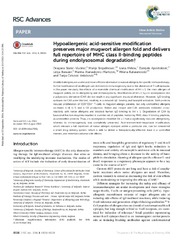Prikaz osnovnih podataka o dokumentu
Hypoallergenic acid-sensitive modification preserves major mugwort allergen fold and delivers full repertoire of MHC class II-binding peptides during endolysosomal degradation
| dc.creator | Stanić-Vučinić, Dragana | |
| dc.creator | Stojadinović, Marija | |
| dc.creator | Mirkov, Ivana | |
| dc.creator | Apostolović, Danijela | |
| dc.creator | Burazer, Lidija | |
| dc.creator | Atanasković-Marković, Marina | |
| dc.creator | Kataranovski, Milena | |
| dc.creator | Ćirković-Veličković, Tanja | |
| dc.date.accessioned | 2021-02-18T10:46:18Z | |
| dc.date.available | 2021-02-18T10:46:18Z | |
| dc.date.issued | 2016 | |
| dc.identifier.issn | 2046-2069 | |
| dc.identifier.uri | http://intor.torlakinstitut.com/handle/123456789/456 | |
| dc.description.abstract | Modified allergens are a safer and more efficient alternative to natural allergens for specific immunotherapy. As the modification of an allergen can diminish its immunogenicity due to the alteration of T-cell epitopes, in this paper we study the effects of a reversible chemical modification of Art v 1, the main allergen of mugwort pollen, on its allergenicity and immunogenicity. Modification of Art v 1 by cis-aconitylation into a polyanionic derivative (CAA) did not result in any significant structural alteration. However, IgE-binding epitopes on CAA were blocked, resulting in a reduced IgE-binding and basophil activation. Both proteins induced proliferation of CD3(+)CD4(+) T-cells in mugwort-allergic patients, but only unmodified allergens increased IL-4, IL-5 and IL-10 production. Rabbit and mouse anti-CAA antibodies exhibited cross-reactivity with native allergens and blocked human IgE-binding to Art v 1. Degradation of CAA by lysosomal fraction enzymes resulted in a similar set of peptides, harboring MHC class II-binding peptides, as unmodified proteins. Thus, cis-aconitylation modified Art v 1 had a significantly reduced allergenicity, whereas its immunogenicity was completely preserved. Acid-environment-responsive modification, which releases a full repertoire of native allergen epitopes within a particular site, can be considered a smart drug delivery system, which is able to deliver a therapeutically-effective dose in a controlled manner, and minimizes adverse side effects. | en |
| dc.publisher | Royal Soc Chemistry, Cambridge | |
| dc.relation | info:eu-repo/grantAgreement/MESTD/Basic Research (BR or ON)/172024/RS// | |
| dc.relation | info:eu-repo/grantAgreement/EC/FP7/256716/EU// | |
| dc.rights | openAccess | |
| dc.rights.uri | https://creativecommons.org/licenses/by-nc/4.0/ | |
| dc.source | RSC Advances | |
| dc.title | Hypoallergenic acid-sensitive modification preserves major mugwort allergen fold and delivers full repertoire of MHC class II-binding peptides during endolysosomal degradation | en |
| dc.type | article | |
| dc.rights.license | BY-NC | |
| dc.citation.epage | 88228 | |
| dc.citation.issue | 91 | |
| dc.citation.other | 6(91): 88216-88228 | |
| dc.citation.rank | M22 | |
| dc.citation.spage | 88216 | |
| dc.citation.volume | 6 | |
| dc.identifier.doi | 10.1039/c6ra17261j | |
| dc.identifier.fulltext | http://intor.torlakinstitut.com/bitstream/id/286/453.pdf | |
| dc.identifier.scopus | 2-s2.0-84988452156 | |
| dc.identifier.wos | 000384571800046 | |
| dc.type.version | publishedVersion |

